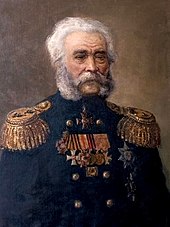Pyotr Fyodorovich Anjou
Pyotr Fjodorowitsch Anjou ( Russian Пётр Фёдорович Анжу ; born February 15, 1796 in Vyshny Volotschok ; † October 12, 1869 in Saint Petersburg ) was a Russian polar explorer and admiral . Between 1820 and 1824 he explored and mapped several of the New Siberian Islands and created the first accurate maps of the coastline between the Olenjok and Indigirka rivers .
Early days
Anjou came from a Protestant family who had emigrated from France to Russia a few decades before he was born. The son of a doctor embarked on an officer career in the Navy. After attending a cadet school in Saint Petersburg, he served on ships in the Baltic Sea .
Expedition to the North Siberian coast
At the beginning of the 19th century, the coastline in northeast Russia and Siberia was largely unknown. Only Vitus Bering had visited the area during his expedition in the years 1733–43. The Swedish researcher Mathias of Hedenström went during an expedition from 1808 to 1811 reports of land northeast of the Lena Delta in Siberia and explored the New Siberian Islands. He also reported on further land northeast of these islands, which he called Sannikow Land .
After Napoleon's Russian campaign in 1812, the Russian admiralty decided to put together an expedition under the leadership of the German-Baltic lieutenant Ferdinand von Wrangel to explore the area of the New Siberian Islands and the coastline there. Knowing the exact geography in this area could be of strategic importance in future wars. The expedition was to be divided into two groups: one group was to explore the area north of the Chukchi Peninsula from Kolyma , while the second was to set up its base in Ust-Jansk on the banks of the Jana and explore the New Siberian Islands from there. Wrangel himself took over the leadership of the first group and gave his friend Pyotr Anjou, whom he knew from the time together at the cadet school, responsibility for the second group.
On May 23, 1820, both groups left Moscow . They reached the Lena via Irkutsk and Jakutsk . The group around Anjou then went on to Ust-Jansk, where they wintered and started work in March 1821. First she went dog sledding to Stolbowoi and then mapped the Kotelny Island . From there, Anjou drove north in search of the Sannikow Land, but after about 80 km encountered open water, which surprised him. At that time it was assumed that the entire Arctic Ocean was covered by an ice sheet all year round. Anjou also had to abort two further attempts to the north because open water made it impossible to continue. Anjou had discovered the southern foothills of a large polynya off the northern coast of Siberia, an area in the Arctic Ocean that never froze over. Wrangel, too, had to abandon his search for Sannikow Land after encountering the same polynya.
As the ice thickness continued to decrease over the summer, Anjou returned to the mainland and explored the coastal area between Jana and Indigirka . After another winter in Ust-Jansk, he split up his group in the spring of 1822. One group, led by Petr Ivanovichlassung, was supposed to map the coastline west of the Jena, while Anjou and the second group went again to search for Sannikow-Land. He first explored the Lyakhov Islands and then tried again to get further north from the Faddejewski Peninsula . After only about 20 km he had to turn back because the ice cover was too thin.
Anjou began to doubt that Sannikow Land actually existed - in any case one could only get there by boats, which his expedition did not have. After another winter, he explored three smaller New Siberian islands from February 1823: Wassiljewski , Semjonowski and Belkowski . After mapping the entire area, he returned to Ust-Jansk on March 23rd. In the summer he finally made his return trip. He met with Wrangel in Yakutsk, and they both returned to Saint Petersburg in August 1824.
More years
As a result of his expedition, Anjou suffered from rheumatism . In 1825 and 1826 Anjou carried out cartographic expeditions to the Caspian Sea and the Aral Sea . On board the battleship Gangut , he took part in the Battle of Navarino in 1827 and suffered serious wounds. From 1828 to 1840 he was in command of several warships in the Baltic Sea. In 1866 he was promoted to admiral . He died in Saint Petersburg in 1869 at the age of 73.
The Anjou Islands and the Anjou Peninsula were named after Anjou . He was a bearer of the Order of St. George and the Order of St. Vladimir , each fourth class.
literature
- Vladimir Dmitrijew et al .: Morskoi enziklopeditscheski slowar , vol. 1. Sudostrojenije, Leningrad 1991, p. 67. ISBN 5-7355-0280-8 (Russian)
- Aleksandr Aleksandrowitsch Polowzow (ed.): Russki Biografitscheski Slowar , Vol. 2 (Aleksinski – Bestjuschew-Rjumin), Saint Petersburg 1900, pp. 144 f. (Russian; digitized version in the Russian State Library )
- William James Mills: Exploring Polar Frontiers - A Historical Encyclopedia . tape 1 . ABC-CLIO, 2003, ISBN 1-57607-422-6 , pp. 26th f . ( limited preview in Google Book search).
- Article Pyotr Fjodorowitsch Anjou in the Great Soviet Encyclopedia (BSE) , 3rd edition 1969–1978 (Russian)
| personal data | |
|---|---|
| SURNAME | Anjou, Pyotr Fyodorovich |
| ALTERNATIVE NAMES | Анжу, Пётр Фёдорович (Russian); Anjou, Peter; Anhu, Pyotr Fyodorovich |
| BRIEF DESCRIPTION | Russian admiral and polar explorer |
| DATE OF BIRTH | February 15, 1796 |
| PLACE OF BIRTH | Vyshny Volochok |
| DATE OF DEATH | October 12, 1869 |
| Place of death | St. Petersburg |

